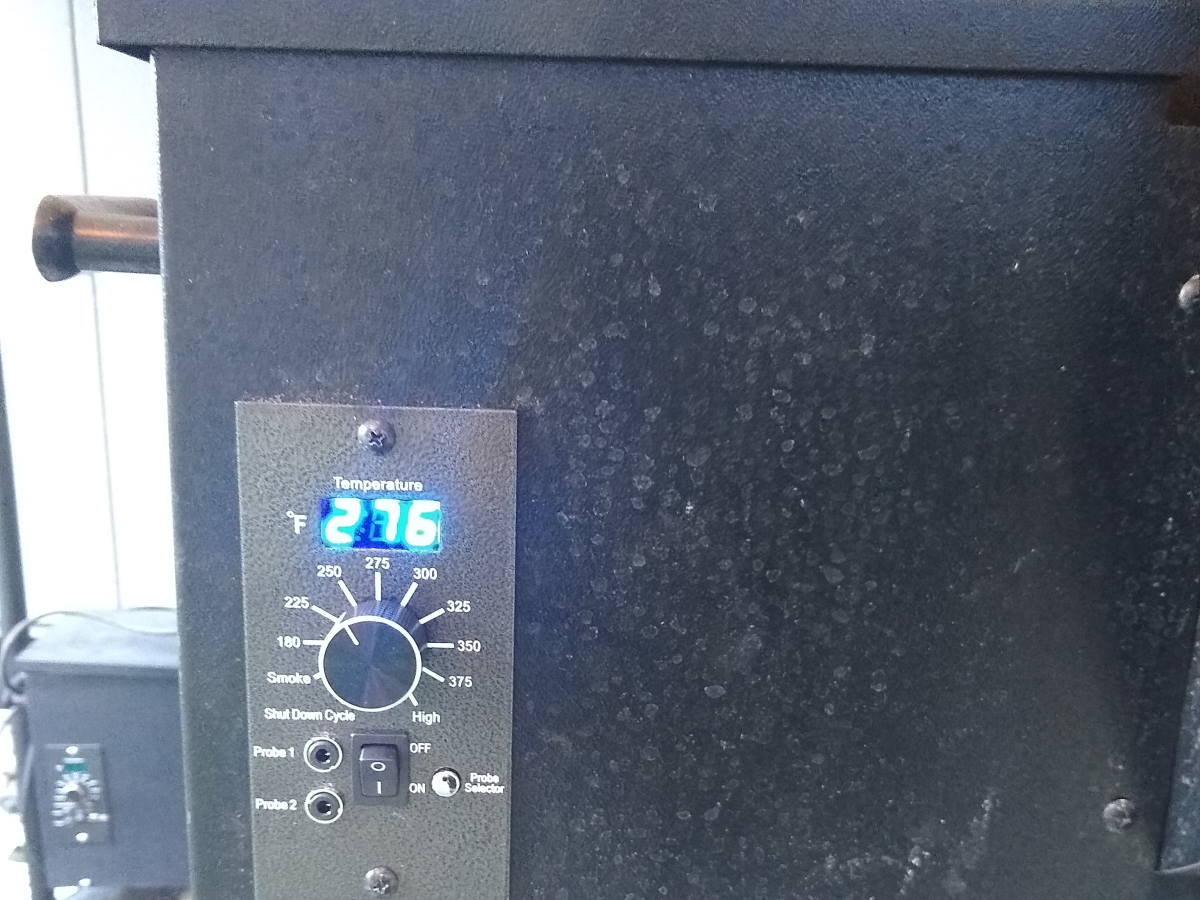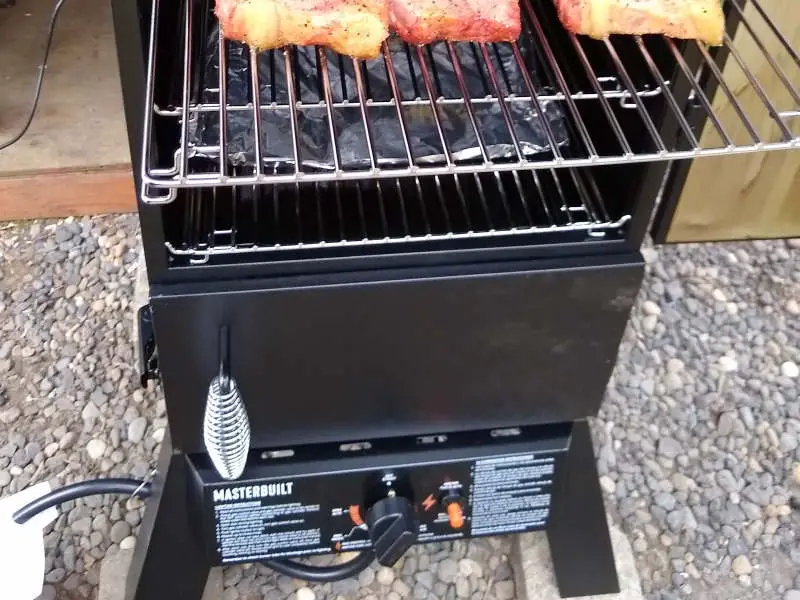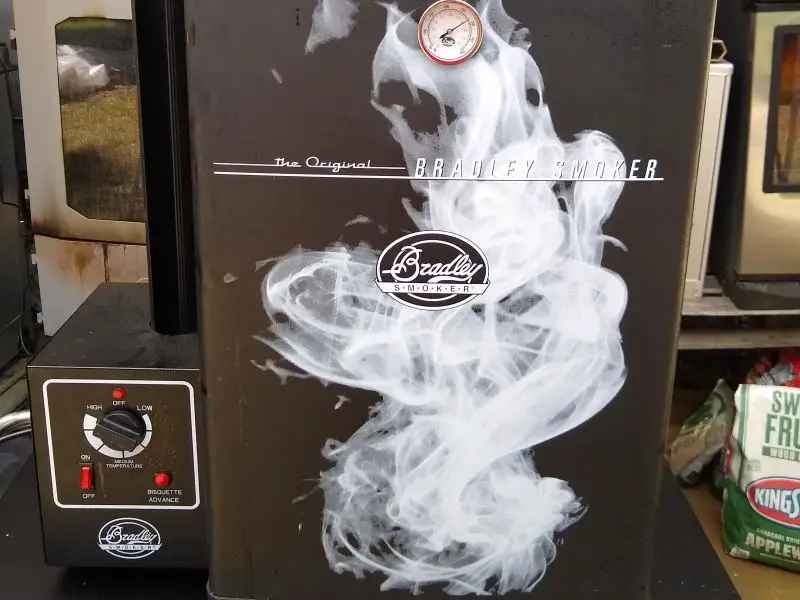
A typical smoker can run from 165 to 400 degrees Fahrenheit. However, some smoker/grill combinations can reach temperatures as high as 700 degrees for searing.
Electric smokers normally run on lower temperatures ranging from 165 to 270 degrees, while charcoal or wood smokers tend to go from 225 to 400 degrees to work efficiently. Propane smokers typically run from 180 to 350 degrees but perform best around 250 degrees.
This article will discuss what affects smoker temperatures and how to adjust for smoker temperatures, then we will cover ranges for popular smokers and some tips.
Note: most links in this article are Amazon.com Affiliate links, see Affiliate Disclosure, thank you.
What is the Temperature Ranges for a Smoker?
If you are trying to control the temperature of your smoker, you will find that you can’t just set it to a particular setting, and everything will be fine. Many different factors come into play while maintaining the levels of smoke in the smoker and keeping it at the right temperature. So many things could change the smoker’s temperature in an instant if you are not paying attention to them.
The good news is that there are ways to manipulate these problems to either work to your advantage or to get your smoker under control. While there may be dozens of things that could go wrong during the smoking process, we found that these are the main factors that will affect the smoker the most.
Air Flow/Ventilation
How well your airflow on your smoker is will determine how your smoking process proceeds. There are a couple of things to think about when it comes to the ventilation on your smoker. If the vents are open, you are allowing airflow to pass through the smoker, which will eventually raise the smoker’s temperature.
Depending on how much air passes through the smoker, it could cause flare-ups if you are using wood or wood chips. You will want to douse those flames so that you will be able to maintain the temperature and get the smoke rolling again.
If the temperature of your smoker gets too high, then you may want to close the vents. This will help lower the smoker’s internal temperature and cause a few problems like creating “dirty smoke,” “black rain,” and smoldering wood. These are all bad things for the meat in the smoker and need to be avoided.
Try to keep an eye on the airflow of the smoker in order to maintain the temperature and keep the air within the smoker clean.
The Weather/Environment
The weather is an obvious factor when it comes to smoking food outside. If it is raining or snowing, it will cool the smoker down faster, so you will have to work harder to keep your fire going to raise the smoker’s temperature. If you are able to keep the smoker covered or out of the precipitation, that is a huge plus. But there are other factors to still worry about.
The temperature of the environment outside will play a huge role as well. If it is hot outside, it will not be that hard to raise the temperature of the smoker very quickly. If it is bitter cold outside, you may end up using more fuel than you expected to keep the smoker’s temperature up. You can always invest in a smoker blanket for your smoker to protect it from the wind, snow, and cold temperatures while you are smoking.
Make sure to be aware of the wind. This will affect the amount of airflow in your smoker and could cause major flare-ups that will raise and lower the smoker’s internal temperature very often.
The Type of Fuel Used
The type of fuel will also be important in how the smoker heats up and cools down. It won’t matter too much if you are using wood pellets with an electric smoker or if you are using propane or natural gas. But if you plan to use wood, wood chips, or charcoal, the situation will be vastly different.
Using these types of fuels is much more involved, and you can’t just walk away from the smoker. When you use wood for the smoker, someone needs to be there to maintain the fire, smoke levels, temperature and feed the fire with more wood. This person is most commonly known as the “Pit Master.”
The Type of Food Being Smoked or Cooked
Another factor that doesn’t have as much emphasis as the others is the type of food you plan on smoking. Some food contains a higher amount of water or moisture within them. When they are cooked, the moisture tends to escape from the meat or flesh of the fruit.
This will cause the temperature in the smoker to raise or lower as well as create condensation on the inside of the smoker. If that happens, the process could turn into a steamer instead of a smoker and create what is known as “black rain,” which is bad for the meat you are smoking.
The Type of Smoker Being Used/The Insulation of the Smoker
The last factor on the list is the type of smoker you plan on using to smoke your foods. Not all smokers are created equal. How hot or cold a smoker can get differs from one to another based on the design and construction of the smoker.
How well the smoker is sealed up and how well the insulation on the smoker is will also determine if it will be able to hold heat for longer periods of time or reach particular extremely high or low temperatures at the same time.
We have put together a small list of some of our favorite smokers to use. We will go over each of them and talk about the highs and lows of their temperatures, heat retention, and heat distribution.

How Hot Can a Traeger Pellet Grill Get?
The Traeger pellet grill can run at temperatures that range between 160 degrees and 450 degrees. Older models of Traeger grills have a maximum temperature of 400 degrees; some of the base models have this limit. Setting the temperature range can affect how the Traeger performs.
There is a smoke setting on the grill that is used to start the grill and to smoke foods like fish and jerky at temperatures that are lower than 150 degrees. The temperature on this setting is irregular and, in our testing, has run around 165 degrees.
The 180 degree setting is the lowest temperature setting. We skip this setting and use the 225 degrees setting for low and slow cooking. It can also be used to hold food once they have been cooked at a safe temperature, but if left too long at 180 degrees, your food will dry out.
Base model Traeger smokers adjust in 25 degree increments up to a high setting, roughly 400 degrees. The smoker burner will constantly run in this setting. So it can reach higher temperatures depending on outside temperatures.
Digital Traeger smokers can be adjusted more precisely and monitored with your Bluetooth devices. The Traeger family of smokers has limitations that are more than made up for by their temperature control, convenience, and consistent results.
Click here to read our article Traeger Grills Reviews
How Hot Can a Masterbuilt Electric Smoker Get?
The Masterbuilt electric smoker is able to produce and maintain temperatures between 140 degrees and 270 degrees at any given time. While the setting may go lower, it is hard to produce smoke on most smokers below 140 degrees.
Most Masterbuilt electric smokers will have a difficult time reaching 270 degrees unless the air temperature is above 70 degrees. We got 250 degrees consistently, so adjust your cooking time and process to take this into account.
The digital models of Masterbuilt smokers are very consistent and rarely go above the set temperature, aka “thermal runaway.” As a result, they are great for smoking items like fish that could dry out.
The Masterbuilt analog smokers may vary in temperature when you add wood chips, but you will find your happy medium with practice. After smoking a few pan loads of wood chips, you might consider lowering or raising the temperature depending on your smoking food.
The addition of a cold smoke device makes the Masterbuilt electric smoker a perfect candidate for cold smoking. If the cost of a cold smoke generator is out of your budget, you can use an Amazin Smoke tray and make a smoke collection device.
Click here to read our article Review of Masterbuilt Electric Smoker

How Hot Can a Masterbuilt Propane Smoker Get?
The Masterbuilt propane smoker runs at temperatures of about 175 to 350 degrees for smoking meats. However, it is not recommended or ideal to run the smoker at that high of a temperature while you are smoking food because the wood chips tend to combust.
The ideal temperature for low and slow meats is going to be around 225 degrees within the smoker. Because most Masterbuilt smokers are simple flow valves similar to propane grills, you will need to watch your smoke for a bit to get the perfect temperature.
Some people also like to use a cast-iron skillet to place their wood chips on in the smoker. This keeps them from flaring up during the smoking process and will also balance temperatures in the smoker. Cast iron has excellent heat retention, so it won’t be hard to maintain the temperature once it is adjusted to your liking.
Click here to read our article Review of Masterbuilt Propane Smoker
How Hot Can a Masterbuilt Gravity Series Get?
The Masterbuilt Gravity Series grills are some of the hottest grills on the market. They can reach temperatures between 225 degrees and 700 degrees by adjusting a dial on the control panel.
They claim the grill can reach a temperature of 225 degrees within 7 minutes and reach 700 degrees within 13 minutes. Our testing with standard charcoal and one haystack lighter has shown that it takes an additional 5 minutes, but that is still very reasonable.
You won’t have any trouble getting a nice sear on a steak at 700 degrees. As for a great brisket at 225 or 350 degrees, this smoker is our current champion. The ability to fill with charcoal and maintain it once every other hour is a game-changer for those long 12 to 18 hour cooks.
Don’t plan to use this smoker for cold smoking, but you could use a pellet tube or an Amazin smoke tray in a pinch. Placing the food on the top rack and the tray on the bottom rack will add a bit of smoky goodness to any food, as long as your account for the airflow.
Click here to read our article Masterbuilt Gravity Series 560 Digital Charcoal Grill & Smoker Review

How Hot Can a Bradley smoker Get?
The Bradley smoker is able to control and maintain the smoker at temperatures between 175 degrees and 280 degrees. This smoker is well insulated and performs well in cold weather. However, it can have thermal runaway on hot days.
When using the Bradley analog smoker model, watch the temperature constantly. As the bisquettes burn, the temperature tends to swing up and down. Because of this, we recommend Bradley’s digital models. The digital controller maintains temperature within 10 degrees, making for very consistent results.
If you want to use the smoker for cold smoking, you will need to purchase the cold smoke adaptor. But if you have that and plan on using the cold smoking function, the smoker will reach temperatures of 55 degrees to 85 degrees.
These temperatures will only be correct in optimal weather and environmental conditions.
Click here to read our article Review of the Bradley 4 Rack Electric Smoker
How Hot Can a Big Chief Smoker Get?
The Big Chief Smoker runs a consistent temperature of 165 degrees. In fact, the company prides their smoking equipment on having one stable temperature that will be reached and maintained every single time.
Their ideal temperature of 165 degrees can be somewhat low when it comes to smoking meats and is not suitable for brisket or pulled pork. However, this temperature is ideal for fish and jerky. Additionally, Big Chief smokers can work well to dehydrate foods but impart a smoky taste if your smoker is well seasoned.
Of course, the environmental temperature will make a difference in smoker temperature. Consider a smoker blanket on cold days to insulate your smoker and get consistent results.
Whether it is a Big Chief or a Little Chief smoker, they both will reach the same temperature every time.
Click here to read our article Smokehouse Products Big Chief Top Load Smoker Review
Conclusion
Smokers can be tricky when controlling and maintaining the smoking temperature while still creating a nice clean smoke to provide flavor for the meats. Each smoker will have their tips and tricks to get all these factors just right.
But we hope that this information will help you figure all of that out when the time comes. Let’s get smokin’!
